This website uses cookies to improve your browsing experience and analyze the use of the website. Learn More

Reserve Your Spot with Confidence! Full Refunds with 24 Hrs Notice. Reschedule at any point, even after tour, if space allows!
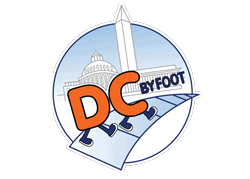
Arlington Cemetery Self-Guided Walking Tour

Welcome to Arlington National Cemetery
Duration: This tour should take you approximately 3 hours.
Distance: It's approximately 2 miles total walking. ( Warning: there is uphill walking for the first half of this tour)
(Stop A) - The first stop for any visit to America’s most hallowed grounds is the Visitor’s Center .
Inside the Visitor’s Center, you will find restrooms and water fountains. I encourage to take advantage of the opportunity here, as facilities are limited throughout the cemetery.
There is also a gift shop here, one of only two sites at the cemetery to sell bottled water - especially important on a warm day! The other spot to purchase bottled water is the Military Women's Memorial, also near the entrance to the cemetery.
To enter the Visitor Center, you will need to go through Security.
For more information about security and the best way to find the starting point, visit this page.
In the center of the Visitor’s Center, you will see a round information desk. Here you can find a map of the cemetery as well as information on various events and how to download the Arlington National Cemetery free app for your smartphone.
Cemetery staff is also on hand to assist you with finding individuals that are buried here at Arlington.
If you are here to find a particular grave marker, please provide the name to the staff at the desk and they will be able to help you. You’ll also notice two computer stations in the center lobby - these stations can help you located individual graves, points of interest throughout the cemetery, and a schedule of events for your date of visit, including wreath layings at the Tomb of the Unknown Soldier.
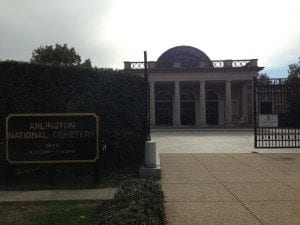
If you feel that you may not be up to walking through the cemetery, Arlington operates a bus tour that allows you to hop on and off at the major sites within the cemetery - including the Kennedy Grave Site, the Tomb of the Unknown Soldier, and the Arlington House and more.
Please note that Arlington does not provide wheelchair or stroller rentals nor do they allow bicycles inside the cemetery.
From the Visitor Center, you will see a winding sidewalk to head into the cemetery, past the Welcome to Arlington National Cemetery sign. This is to the north of the Visitor Center on the opposite side from the parking lot. Cross over Eisenhower Drive at the pedestrian crosswalk and stop as you enter the burial grounds.
(Stop B) - Welcome to Arlington National Cemetery . Arlington is the final resting place for over 400,000 of America’s heroes and their families. Throughout the 624 acre cemetery, you will find grave markers honoring casualties and veterans from every American conflict, from the Revolutionary War to today.
Keep in mind that Arlington is first and foremost an active military cemetery - every day but Sunday, 25-30 burials take place throughout the cemetery and it is possible that during your visit today, you will encounter a funeral honoring one of our fallen heroes. If you look to the house at the top of the hill, you’ll see a flag pole.
This flag is lowered to half-staff 30 minutes prior to the first funeral of the day and it remains down until 30 minutes after the last funeral of the day. This indicates to all visitors whether or not funerals are occurring during their visit.
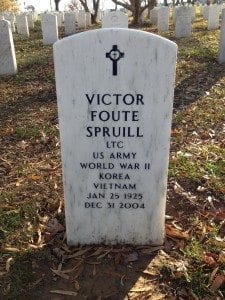
What exactly does it take to be eligible for burial here at Arlington National Cemetery? There are several ways to qualify for in ground burial here -
- First, any service member in any branch of the United States Armed Forces who is killed in action is qualified for burial.
- All retired veterans who served at least 20 years and were honorably discharged are eligible as are all prisoners of war.
- Any service member who was awarded the Medal of Honor, Distinguished Service Cross, Navy Cross, Air Force Cross, Silver Star, or Purple Heart is qualified, regardless of length of service.
- Any former member of the Armed Forces who served for any length of time and also served in an elected office of the United States Government, on the United States Supreme Court, or a Cabinet level position of the United States government.
- Any President, regardless of military service, is eligible as Commander in Chief.
- Any spouse or dependent child or permanently dependent child of a qualified service-member is also eligible for burial here.
- Finally, the Department of the Army, which operates this cemetery, may grant special permission for burial here at Arlington National Cemetery.
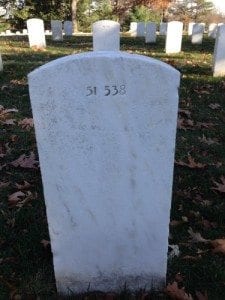
As you look around the cemetery, you’ll notice that all the grave markers in these sections are identical, stretching out as far as the eye can see. You are in what is known as the new section of the cemetery.
To be buried in a new section, your family must consent to having a government issued grave marker. The markers are made from either Georgia or Vermont marble and are exactly 42 inches tall, 13 inches wide and 4 inches deep. You’ll notice that they have a standard set of information.
If you look to your right, the front of the grave marker lists the servicemember being honored, the highest rank attained, their branch of the Armed Forces, any wars in which they served active duty, and the dates of birth and death.
If any special medals of commendation were awarded, they are listed at the bottom of the grave marker using initials. PH stands for Purple Heart. At the top, you may notice an optional emblem of belief - there are over 50 different religious symbols that can selected.
On the back of the grave marker, you’ll notice a set of numbers. The first number is the section. There are over 70 different sections throughout Arlington National Cemetery. They are roughly organized chronologically but there are a few special sections, including a section for military police, a section for nurses, and a special section for Supreme Court Justices.
The second number you see is the individual grave marker number. Every single grave has a unique number to help visitors locate individual graves. Finally, you may notice additional names listed on the back. These include spouses and dependent children who are buried with the servicemember.
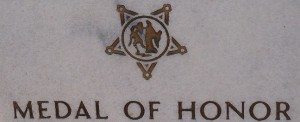
The new sections of the cemetery which restrict new burials to government issue gravemarkers help to address one of Arlington’s most pressing issues - space.
While the Cemetery is currently undergoing an expansion of the grounds, there is limited space to continue adding new graves. Given the current rate of burial, it is predicted that Arlington National Cemetery will be full by 2050.
At that point, it will close to active burials and become a national shrine. As you continue this walking tour, you will notice that as you move into older sections of the cemetery, grave markers will get larger and more ornate. In the old sections of the cemetery, family members can, at their own expense, create their own grave markers.
Keep in mind that size and shape of a marker does not necessarily indicate a certain rank or stature but simply the wishes and resources of the family.
Continue up Roosevelt Drive and look to the right to find the grave marker of William Windrich with what looks like a star underneath his name. His marker is often honored with a small American flag.
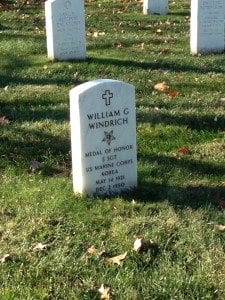
(Stop C) - If you take a look at the grave marker for Staff Sergeant William G. Windrich , you may notice that it looks slightly different from the grave markers surrounding it. Look closely at the lettering - you may notice that the lettering is done in gold.
You may also notice a special emblem located on this marker, directly under the name - that is the symbol for the Medal of Honor , the highest military decoration in the United States.
As you explore the cemetery, you may notice other grave markers with gold lettering and the Medal of Honor emblem - as of January 2014, there are approximately 400 Medal of Honor recipients buried at Arlington National Cemetery.
Windrich’s story of heroism and sacrifice is one of many that can be found in here. He joined the United States Marine Corps at the age of 17 in 1938. He fought bravely as a machine gunner during World War II and chose to reenlist following his honorable discharge in 1945.
When the Korean War started in 1950, Windrich was among the first Marines to see action. On December 1, 1950, his battalion faced a vicious counterattack in the dead of night.
As detailed in his Medal of Honor citation, Staff Sergeant Windrich valiantly fought off the attackers to allow for his men to withdraw to a safer position. Under heavy fire and despite being injured, he organized the medical care and treatment of his fellow Marines, refusing medical attention for himself. As his battalion continued to face attack, he shouted words of encouragement and refused to be evacuated until the attack was repelled.
While his battalion was victorious in battle, Windrich was weakened by bitter cold and excessive loss of blood and died just as the enemy was retreating. In addition to being awarded the Medal of Honor for his bravery and sacrifice that day, Windrich has also been awarded two Purple Hearts and the Combat Action Ribbon, among several other decorations for his service.
Continue up Roosevelt Drive, just past Weeks Drive on the right to a small wooded area surrounding the equestrian statue.
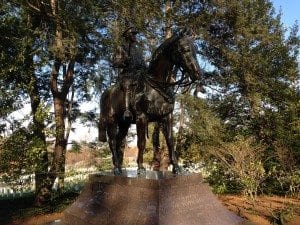
(Stop D) - You are now standing in front of one of only two equestrian statues at Arlington National Cemetery. This statue marks the gravesite of an exceptional military hero, Field Marshal Sir John Dill .
As you may be able to guess from the rank and title, Sir John is not an American soldier, but rather, a British commander with a special relationship to the United States Armed Forces.
Sir Dill’s military career began in World War I, when he served with distinction and earned several foreign decorations for his service. Following the Great War, he became a gifted military instructor and continued to serve the United Kingdom in several distinguished posts.
He obtained the rank of Field Marshall in 1941, the highest rank in the British Army. As the United States entered into World War II, Sir Dill was sent to Washington, DC as the Senior British Representative for the Combined Chiefs of Staff. Sir Dill worked alongside General George Marshall, coordinating the efforts of British and American troops throughout World War II.
President Franklin D. Roosevelt said that Dill was “the most important figure in the remarkable accord which has been developed in the combined operations of our two countries.” Sir John Dill died of a rare blood disease in 1944, while working in our nation’s capital.
His funeral service was held at Washington National Cathedral and special permission was granted, at the urging of General George Marshall, to have Sir Dill laid to rest here at Arlington. Sir John Dill is the first non-American to be interred at Arlington National Cemetery. As of January 2014, there are 62 foreign nationals buried at Arlington.
Backtrack slightly down Roosevelt Drive and turn left on Weeks Drive. This dead ends at Sheridan Drive, which you will cross to reach the plaza at the Kennedy Memorials. Our next stop, Justice Hill, is up the ramp to the right. From here you will be viewing the backs of the headstones. If you'd like to see them from the front, walk along Sheridan Drive to the right before entering the plaza.
Stop in front of the large bench-like tombstone for John W. Weeks to view the front of many of these headstones on Justice Hill.
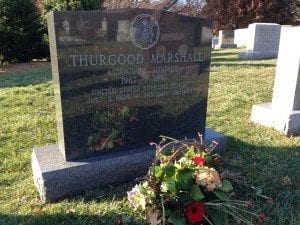
(Stop E) - Among the military heroes and leaders who are honored here at Arlington, a special section has been designated to honor those who have served in our judicial branch - Supreme Court Justices. There are 13 Justices buried at Arlington, with 9 of them located in Section 5 in what is often referred to as “ Justice Hill .”
Right in front of you, you should see a grave marker with a bench element. This is the grave site for Lt. John Wingate Weeks, former Secretary of War and a distinguished Congressman from Massachusetts who served in the United States Navy.
Directly behind Lt. Weeks’ grave marker is Justice Hill. This small section includes the graves of two former Chief Justices - Warren Burger and William Rehnquist. There are eight associate justices, including Thurgood Marshall, the first black-American to serve on the Supreme Court and William O. Douglas, the longest serving justice in the history of the Court. Justice Douglas served on the bench for 36 years and 7 months!
Also buried in Section 5, is Justice Oliver Wendall Holmes, Jr., a Civil War veteran with a long history of judicial service. He retired from the Supreme Court at the age of 90, the oldest justice to have served the Court. You will also see Ruth Bader Ginsburg and her husband Martin buried here.
Continue around the granite ramp to the right to make your way to President John F. Kennedy's memorial. The accessible route for wheelchairs and strollers will veer off to your right before you approach the stairs. As you climb the three stairs into the memorial area, the eternal flame will be up another set of stairs to your right. (Please remember this is a place of silence and respect, if you are not listening with headphones, please play this next stop before entering the memorial)
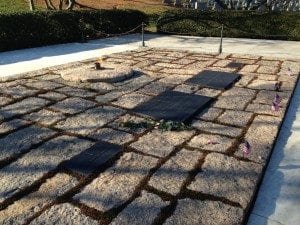
(Stop F) - One of the most famous Americans to be laid to rest here at Arlington National Cemetery is President John F. Kennedy . One of only two Presidents buried here (the other being William Howard Taft), President Kennedy’s gravesite attracts millions of visitors a year from all over the world to pay respects to the man whose life and work was tragically cut short. President John F. Kennedy made his first formal visit to Arlington on November 11, 1961 to lay a wreath at the Tomb of the Unknown Solider.
As a young Navy hero who served in World War II, President Kennedy spoke intimately that day about sacrifice and service. President Kennedy would return to Arlington two years later, on November 11, 1963. That would be his last visit to the cemetery alive - he would be assassinated in Dallas, TX eleven days later.
In March of 1963, on a visit to Arlington, Kennedy made his first and only visit to the Lee Mansion. As a history buff, the president was well versed in the history of the mansion and the grounds, relishing the opportunity to spend time in the room where Robert E. Lee penned his resignation from the U.S. Army. Moments later, the president would be staring out across the cemetery and the city, enjoying the view. It's at this moment that he said "I could spend forever here."
Kennedy’s assassination was felt across every corner of the nation and across the globe. Kennedy’s widow, Jacqueline Bouvier Kennedy, made the difficult decision to have her husband buried here, as opposed to in his home state of Massachusetts. She simply stated that “he belongs to the people” and should be buried in a place where the people of the nation would be able to come and mourn their slain President.
On November 25, 1963 at 3:00 pm, the state funeral for President Kennedy began. As mourners gathered around the gravesite, 50 Navy and Air Force jets flew overhead while Air Force One, the President’s private plane, dipped it’s wing during the flyover as a final tribute.
After Jackie Kennedy was given the American flag that draped her husband’s casket, she used a torch to light the Eternal Flame. As you walk up to the Kennedy Gravesite, you will see four gravemarkers - President John F. Kennedy and First Lady Jacqueline Kennedy Onassis (she later remarried but chose to be buried her with her first husband) as well as two smaller stones.
These are two children who preceded President Kennedy in death - a boy, Patrick, and an unnamed stillborn girl. The Eternal Flame that you see at the gravesite burns 24 hours a day, 7 days a week, reminding us of Kennedy’s unyielding legacy.
After you've paid respects at JFK's grave, you can exit the memorial area the opposite way you entered, to the right as you descend the stairs from the eternal flame. You'll see a long granite wall and sidewalk leading to your right to reach Senator Robert F. Kennedy's grave, a small wooden headstone to your right. (Please remember this is a place of silence and respect, if you are not listening with headphones, please play this next stop before entering the memorial)
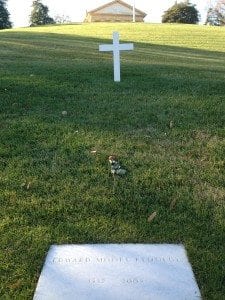
(Stop G) - Senator Robert F. Kennedy - President John F. Kennedy is not the only Kennedy brother to be buried at Arlington National Cemetery. As you continued down the path leaving the President’s gravesite, you’ll notice a small wooden cross.
This marks the gravesite for Senator Robert F. Kennedy. Bobby Kennedy, brother of the President and former Attorney General of the United States, was a United States Senator when he was campaigning for the Presidency in 1968. Following his victory in the California Primary, at a celebration at the Ambassador Hotel on June 5, 1968, Kennedy was assassinated as he was exiting through the kitchen of the venue.
Although Senator Kennedy had publicly stated his intention to be buried in Massachusetts, the Kennedy family believed he should be interred next to his brother. Senator Kennedy’s funeral was the only one to ever take place at Arlington National Cemetery at night.
If you look across the plaza from the white wooden cross, you will see a small memorial wall, featuring two quotations from Senator Kennedy’s career. The first quote comes from a speech Senator Kennedy gave in South Africa, during a 1966 tour to champion the anti-apartheid cause.
The second quotation was given just a few months prior to his assassination during a campaign event in Indianapolis. While campaigning for the Presidency, Senator Kennedy learned of the assassination of civil rights leader Martin Luther King Jr. Kennedy’s staff advised him against making any public appearances that evening, fearing riots and violence.
However, Senator Kennedy insisted on delivering an impromptu, heartfelt speech to the gathered crowd about his own experience with grief and losing his brother to assassination. Riots broke out in 60 cities across the country following the news of King’s death but Indianapolis was not one of them, a fact attributed to the power of Senator Kennedy’s speech.
Continue along the granite sidewalk opposite the side you came in as it circles back to the road. You will see the next two stops on your right. (Please remember this is a place of silence and respect, if you are not listening with headphones, please play this next stop before entering the memorial)
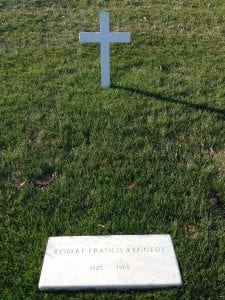
(Stop H) - Senator Ted Kennedy - As you continue down the path away from Robert F. Kennedy’s gravesite, you’ll notice a second white wooden cross - this marks the gravesite for another Kennedy brother honored here at Arlington National Cemetery, Senator Edward M. Kennedy.
Senator Kennedy was the last surviving Kennedy brother and when he passed away in 2009, he was the fourth-longest serving member of the United States Senate, having served for almost 47 years. Senator Kennedy was first elected to the Senate in a special election to fill the seat that was left open when his brother John won the presidency and was reelected eight more times before his death.
He was known as “The Lion in the Senate” and had more than 300 bills that he authored enacted into law. Unlike his older brothers, each of which served in the United States Navy, Senator Kennedy attained the rank of Private First Class in the United States Army.
The two white wooden crosses marking the graves of Robert and Edward Kennedy are the only white wooden crosses throughout all of Arlington National Cemetery.
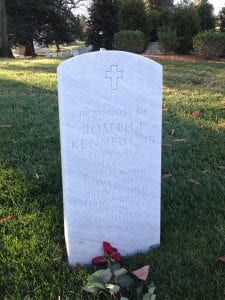
(Stop I) - Joseph Kennedy Jr. - The last Kennedy brother to be honored here at Arlington National Cemetery is Joseph P. Kennedy Jr, the eldest of the Kennedy sons. Shortly following the attack on Pearl Harbor, like many brave young men of his generation, Joseph Kennedy Jr. dropped out of law school and began flight training in the United States Navy.
By 1944, he had completed 25 combat missions and was eligible to return home. Instead, he volunteered for Operation Aphrodite. On August 12, 1944, Lieutenant Kennedy was declared killed-in-action, due to an explosive on his plane being detonated prematurely. He was posthumously awarded the Navy Cross, the Distinguished Flying Cross, and the Air Medal.
As you look at Lt. Kennedy’s marker, you’ll notice the wording just under the cross - “in memory of.” Lt. Kennedy’s remains were never recovered, so what you’re looking at is not a grave marker but a cenotaph. Cenotaph comes from the Greek word for “empty tomb” and cenotaphs are used throughout Arlington National Cemetery to honor those who are eligible for ground burial here but whose remains could not be recovered as well as for those who have chosen to donate their bodies to science.
As you exit the Kennedy Memorial's granite sidewalk, look up the hill to your right. At the top of the hill to the left of the house, you'll see a large dark bullet-shaped headstone in front of the trees.
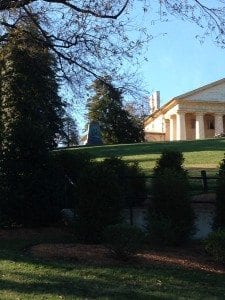
(Stop J) - General Philip Sheridan - You are now standing on Sheridan Drive, named after one of the 3 great Union (northern) generals during the U.S. Civil War. Arlington Cemetery was established with the intention that it would be a resting place for lower ranked officers and enlisted men.
Sheridan requested burial in Arlington Cemetery right in front of Arlington House, Robert E. Lee's home. You can see his bullet shaped tombstone at the top of the hill. Coincidence? Probably not. Nevertheless, Sheridan's burial opened up the cemetery to other prominent military men and is a watershed moment in the history of the cemetery and it's popularity.
Continue up the hill on Sheridan Drive, shortly after the exit from the Kennedy Memorials on your right you'll see a reddish headstone next to the road.
(Stop K) - Senator Frank Lautenberg and Secretary Robert McNamarra - There are many well known people buried in Arlington National Cemetery, as you already know. Here are two more.
Robert McNamarra, was the Secretary of Defense under Presidents Kennedy and Johnson, a tenure that coincided with the most important years of U.S. involvement in the Vietnam War. Senator Frank Lautenburg of NJ was the last serving U.S. Senator with WW2 experience. His death marked a symbolic end of a generation in power.
Continue up the hill on Sheridan Drive as it curves to the right. As you come to the stairwell that crosses the road, take the stairs to the right up the hill. When you've reached the top, turn right along the paved sidewalk and follow it as it curves to the left - be careful as it becomes unpaved here! Stop anywhere along the flower garden for the next stop.
(Stop L) - Flower Garden - Once you get to the top of the stairs, you have reached the flower garden of Mrs. Lee and you have effectively reached the top of the hill. General Meigs did not formally establish the lands of the Lee-Custis Estate until June 15th 1864. Burials would begin approximately 1 month beforehand.
Enlisted men would be buried on lower lands and officers would be buried closer to the Lee-Custis mansion. Meigs wanted to make any return of Lee-Custis decedents very undesirable. The removal of the remains of Union officers would be politically unlikely. Take a look at some of the dates of the headstones around the garden.
As you're walking along the unpaved walkway along the edge of the hill, you're surrounded by some of the oldest graves in the cemetery with a view of Washington, DC through the trees on your right. As the trees end, you'll see a large table-like sarcophagus to your right next to the flagpole. This is the grave of Pierre (Peter) L'Enfant.
(Stop M) - Pierre (Peter) Charles L'Enfant - The tomb before you belongs to one of America's first and greatest immigrants and one of only a handful of Revolutionary War veterans to be re-interred at Arlington National Cemetery. The placard before you shows the original design of the District of Columbia, which L'Enfant produced.
Despite being dismissed by George Washington after a dispute with the city commissioners, L'Enfant's plans can still be felt in the map today. It's a remarkable view of the city of Washington. It's no surprise why President Kennedy remarked that he could spend eternity here.
Across from L'Enfant's sarcophagus to your left, is Arlington House.
(Stop N) - Arlington House - The house before you was built by George Washington Parke Custis, the step-grandson of George Washington. It was originally built to serve as Parke Custis's home as well as a museum to his late great step-granddad. During the American Civil War, it was used as the headquarters of the Union's Army of the Potomac.
The house, as with the land, was confiscated by the Army. The Army eventually would settle with the Lee-Custis decedents. In 1959, on the eve of the 100th anniversary of the start of the war, the house was dedicated as the national memorial to the great Civil War General. The National Park Service runs self-guided tours of the house.
Before moving on, be sure to take advantage of the restrooms and the Robert E. Lee Museum located behind the house to the right. Read more in our blog post on Arlington House .
After you've visited the house and the grounds, make your way behind the house on the same side as the flower garden. With the house to your right and the flower garden to your left, you'll see the unpaved sidewalk leads towards Sherman Drive and the trolley pick up. Before you reach then, under the branches of a large tree, a paved sidewalk heads to the left through an area of manicured shrubs. These bushes surround the memorial to the Civil War Unknowns.
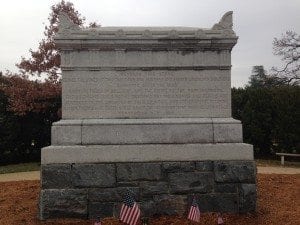
(Stop O) - Civil War Unknowns Burial Monument - As with the graves around the flower garden, General Meigs was motivated by the idea that the former plantation should be made unsuitable for the return of the Lee-Custis decedents.
Below the cenotaph, lie the remains of 2111 unknown soldiers, gathered from battlefields throughout northern Virginia. Since all of the remains contained within the tomb came from unidentified soldiers, Confederate and Union dead are mixed. Originally, the cenotaph had two cannons and a pyramid of cannon shot on its top, but were later removed.
With your back to the Civil War Unknowns, follow the sidewalk out towards the white columns of the Old Memorial Amphitheater. You may walk around or inside the Tanner Amphitheater.
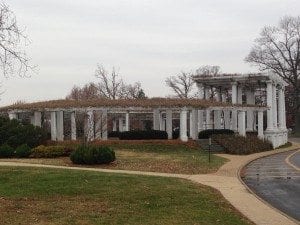
(Stop P) - Old Memorial Amphitheater - Built in 1874, this is the original location of Decoration Day celebrations, that later became Memorial Day. With more people coming to the cemetery to honor American veterans, the new Memorial Amphitheater which can hold many more people was built in 1921.
Since then, this has been the location for a few events through the years. During the 150th anniversary events of the cemetery, the "Old" Memorial Amphitheater was renamed after Union Corporal James R. Tanner, buried nearby. Tanner was wounded at the Second Battle of Bull Run and lost both his legs. He survived to become a stenographer and was present at President Lincoln's deathbed and the trial of the conspirators.
From here, you'll want to cross the immediate Sherman Drive and the next parraell road, Humphreys Drive. Be careful as you cross Sherman Drive here as it's one of the more active roads in the cemetery. Head right down Humphreys Drive towards the Old Administration Building and cross where Humphreys Drive circles back onto itself. Not too far into the headstones on your left you'll see an old cannon, lately (as of Dec. 2014) surrounded by caution tape.
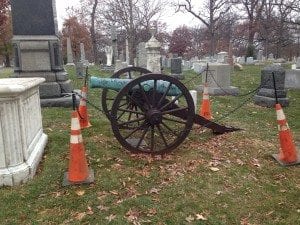
(Stop Q) - Wallace F. Randolph Cannon - Before you is one of the most remarkable "headstones" in Arlington Cemetery. It belongs to Wallace F. Randolph, who enlisted as a private in the Civil War and ended his career as a Major General in 1904 when he retired.
Randolph is purported to have said that since he had spent a career behind a piece of artillery, he didn't mind spending eternity underneath one. It's a 1200 pound (500 kg) Napoleon Cannon. Such eccentric headstones were once acceptable in ANC.
However, today all new headstones must be the uniform white, government issued headstones, such as the ones you have seen throughout the cemetery or if privately issued can only be located in older sections of the cemetery and of "simple design, dignified, and appropriate to a military cemetery." Read our blog post to learn more about burial regulations in Arlington Cemetery.
With Randolph's cannon to your back, cross back over the road in front of you into Section 1. You'll begin veering to the right to find a large white sarcophagus set atop granite stones that is the headstone for Montgomer Meigs. It is okay to walk amongst the headstones in this section.

(Stop R) - Major General Montgomery Meigs - Montgomery Meigs was Quartermaster General through the Civil War and beyond, but as he listed on his sarcophagus he was also an architect (Building Museum, Pension Office), a scientist (regent of the Smithsonian Institute).
Here in Arlington National Cemetery, he is most remembered as its founder. In 1864, with the need for more burial ground for the fallen Union soldiers and a hatred for Robert E. Lee, Meigs ordered 26 Union dead to be buried on the Lee household grounds.
Eventually, Meigs would bury his own son here in Section 1. A sarcophagus covered with a 2/3rd life size bronze relief of John Rodger Meigs lying in the mud on his back, shot and then trampled by Confederate soldiers. Meigs picked this plot for his family and designed his own marble and granite tomb whose base resembled bricks mortared together. His wife, grandfather, and other relatives are buried nearby.
In this same section, walk back towards the Old Memorial/Tanner Amphitheater. You'll see a dark squat obelisk (as if someone shrunk down the Washington Monument), sometimes marked with a few baseballs, and Doubleday written on the front.
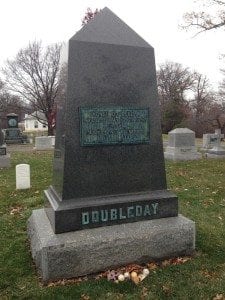
(Stop S) - Major Abner Doubleday - On the left side of Meigs Ave, you will see the large headstone of Major General Abner Doubleday. Doubleday fired the first shot for the Union in defense of Fort Sumter in South Carolina.
Doubleday is often credited with inventing the game of baseball and you will often see baseballs (and sometimes mini-bats and gloves) placed at the base of his grave. Doubleday's role in the creation or evolution is widely disputed. One common story is that Doubleday created baseball by having the British game Rounders played within the confines of the diamond shaped fort that he commanded.
While American Baseball most certainly evolved from Rounders, there appears to be no truth with this Doubleday story. However, what is not disputed is that Doubleday received the patent on the cable car system still in use in San Francisco till this day.
There is a short walk to the next stop. With Doubleday behind you, you'll see the small white Old Chapel across Meigs Avenue, be careful crossing this street as well to head down the hill on Memorial Drive. You'll see the second equestrian statue of Phillip Kearny on your left as you go. As you've reached the valley and are heading back up the next hill, you'll see a section of small white marble headstones on the hill to your right. Alton Glenn Miller's memorial headstone is located in Section MH Grave 464-A.
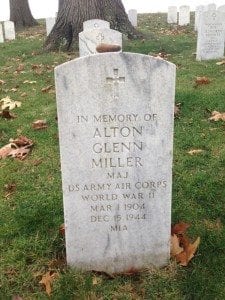
(Stop T) - Alton Glenn Miller - One of the biggest names in music, Glenn Miller, as he was known, gave up his lucrative career to join the military during WW2. The Glenn Miller Orchestra is considered one of the best big bands of all times. He had 23 number 1 hits - which is more than Elvis or the Beatles had during their careers!
At 38, he was deemed too old to enlist in the infantry. Instead, Miller was given permission to form the 50-piece Army Air Force Overseas Orchestra, entertaining troops up to 800 times before his plane disappeared over the English Channel. Glenn Miller, a musician, is an example of the diversity of people interred in Arlington Cemetery.
In addition to musicians, there are politicians, poets, athletes, justices, astronauts, doctors, explorers and more. Arlington National Cemetery is a tapestry of American society. If you don't know who Glenn Miller is, well, there's no chance you haven't heard at least one of his songs. Tap your feet to this famous Glenn Miller Orchestra tune, In the Mood or the Chattanooga Choo Choo .
Continue up the hill on Memorial Drive and cross Farragut Drive. You'll see the large Canadian Cross to your right and behind it, a set of three rectangular stones with a sidewalk to your right leading up to it. Follow the sidewalk to the the viewing area of these memorials. (Please remember this is a place of silence and respect, if you are not listening with headphones, please play this next stop before entering the memorial)
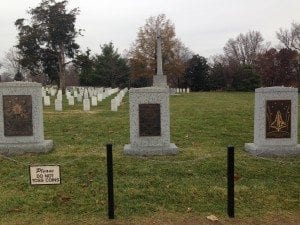
(Stop U) - Challenger and Columbia Space Shuttle and Iran Rescue Mission Memorials - As you rise to the crest of the hill you'll see across from the Memorial Amphitheater, three large memorial stones.
Here we honor the servicemen and women killed in three tragic events. In 1986 while the country watched the first civilian in space, Christa McAuliffe, a Social Studies teacher, and her six fellow astronauts were killed in an explosion.
There are co-mingled cremains in the base of the monument but remains are also buried elsewhere, with pilot Captain Michael Smith and Commander Francis "Dick" Scobee both buried in Arlington.
Next to this memorial is that for the 1980 Iran Rescue Mission Memorial. If you've seen the film Argo, it is the same event where the American Embassy in Iran was held hostage for 444 days. There was a freak accident during a rescue attempt where a cargo plane and helicopter collided, killing eight of the servicemen on board.
After the seven person crew of Space Shuttle Columbia were killed upon re-entering the atmosphere in 2003, an additional memorial was placed here in their honor. Three of it's crew are also buried elsewhere in Arlington National Cemetery.
Exit the viewing area and turn right up the sidewalk to the mizzenmast of the USS Maine.
(Stop V) - USS Maine Memorial - Rising tall in the distance is the original mizzenmast of the USS Maine. This ship was sent to Havana Harbor in 1898 where it sunk - whether by Spanish attacks or internal malfunction has never been satisfactorily determined.
Regardless, the sinking and death of 266 men outraged the American public enough to declare war and begin the Spanish-American War, which led to acquisition of Cuba, Puerto Rica, Guam and the Philippines as American territories. The mast is held aloft by a concrete, marble and granite turret. The names of those men who died on the ship are listed on 23 panels around the base.
There is a large bronze door decorated with a fragment of the ship's bell and flanked by Roman tripods. The interior of the base serves as small room, which from 1941-1992 was the resting place for Ignacy Jan Paderewski, a Polish pianist and spokesman for Polish independence. Paderewski died while on tour in New York and was allowed temporary resting in Arlington National Cemetery by President Franklin D. Roosevelt "until Poland is free."
His remains were honored in the USS Maine Memorial because he never served in the US military and was not eligible for below ground interment. A sidewalk leads up to the base of the USS Maine Memorial where you can walk the base and return via the same sidewalk for the next stop.
Return down the sidewalk the way you came to Memorial Drive, with the mast behind you and the new Memorial Amphitheater in front. Before you cross the road, take the sidewalk to your right. The sidewalk will fork off to circle around a large tree. You'll see one small headstone for Audie Murphy, often covered with flags and stones.
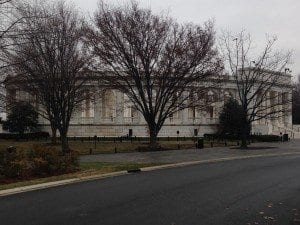
(Stop W) - Audie Murphy - Arlington is the final resting place for so many of America’s heroes but few reached the levelof acclaim and notoriety as Audie Murphy. Audie Murphy is one of the most highly decorated American combat soldiers in our history.
He was awarded every U.S. military combat award for valor available from the U.S. Army, including the Medal of Honor.First Lt. Murphy joined the United States Army following the bombing of Pearl Harbor at 1941. He was only 17 years old but his sister falsfied his birthdate so he could join up. He served with distinction throughout the Mediterranean and European theatres of the war.
Although tales of his bravery have become legend, the events of January 26, 1945 earned him the Medal of Honor and a place in American cultural history. As Murphy’s company awaiting reinforcements, German enemy combantants managed to score a direct hit on a tank, forcing the American soldiers to abandon it and retreat.
Murphy ordered his men out of harm’s way and then lept on top of the abandoned tank, firing alone onto the enemy squad. For an hour, Murphy stood on the tank, returning enemy fire and holding off their advances, despite suffering a serious leg wound. His bravery that day would save the lives of his men. He was all of 20 years old.
Following the war, Murphy capitalized on his notoriety as the most decorated combat soldier of World War II with a career in Hollywood. He starred in over 40 feature films, most notably playing himself in the film adaptation of his memoir “To Hell And Back.” The film became the biggest hit in the history of Universal Studios up to that point.
Like many young men returning from war, Murphy suffered from what was then called “battle fatigue” - we know it today as Post Traumatic Stress. Murphy spoke out publicly about his struggles with PTS and called upon the United States government to better provide mental health services for veterans returning home from the Korean and Vietnam wars. First Lt. Murphy was killed in a passenger plane crash in 1971.
Walk back across Memorial Drive to the Memorial Amphitheater. You'll see the large entrance steps in front of you, facing the USS Maine mast.

(Stop X) - Memorial Amphitheater - The Memorial Amphitheater at Arlington National Cemetery was dedicated on May 15, 1920. While there are ceremonies that take place throughout the cemetery, this location is where the three annual events of Arlington are held - the sunrise Easter Sunday service and the Memorial and Veterans Day ceremonies.
The cornerstone was laid for the Memorial Amphitheater by President Woodrow Wilson. A box was sealed inside the cornerstone that included a copy of The Bible, The Declaration of Independence, a United States Flag, and Pierre L’Enfant’s map design of the city of Washington. The amphitheater is made out of marble quarried from Vermont.
As you look inside the amphitheater towards the stage, you’ll see the names of 14 U.S. Army generals, starting with George Washington on the left, and the names of 14 U.S. Navy admirals, starting with John Paul Jones. If you look up inside the apse surrounding the stage, you’ll see a quotation from George Washington - "When we assumed the soldier we did not lay aside the citizen."
Taking a look outside of the amphitheater, you will see the names of the 44 battles, ranging from the American Revolution to the Spanish-American War, inscribed above the colonnade. On the west entrance of the Amphitheater, in the center, you’ll see a quotation in Latin - “Dulce et decorum est pro patria mori”. Translated it means “It is sweet and fitting to die for one’s country.”
We recommend viewing the Tomb of the Unknown Soldier and changing of the guard ceremony from the south side. If you're inside the amphitheater, walk up to the speakers area and exit the alcove to your right. You'll pass through a small tunnel and see an opening to your left that leads to the Tomb. You can either walk straight out to the balcony to view the changing or you can take the set of stairs that are to your right down one level and around to the left to view the ceremony. If you take the stairs down two levels heading into the basement, you'll find the restrooms and the living quarters for the tomb guards. It is from here they will exit to walk out to the plaza if you want a close up photo - just don't get in their way as they walk!
(Stop Y) - Tomb of the Unknown Soldier - Welcome to the Tomb of the Unknown Soldier, one of the most solemn and moving places here at Arlington National Cemetery. This is the location to view the Changing of the Guard ceremony, which takes place every hour at the top of the hour October 1st-March 31. From April 1-September 30, the ceremony takes place at the top of the hour and on the half-hour.
The Tomb of the Unknown Soldier was authorized by Congress on March 4, 1921, to honor the countless American men who were sent to fight during World War I and never returned home. The remains of one unidentified soldier from World War I were added to the marble sarcophagus behind the recently completed Memorial Amphitheater.
On the east side of the tomb, the side facing Washington, DC, are three figures representing Peace, Victory, and Valor. Inscribed on the west side, facing the Memorial Amphitheater are these words: “Here rests in honored glory, an American soldier known but to God.”
You will see that there are three additional marble slabs that are laid in the plaza. These represent the unknown soldiers for World War II, the Korean War, and the Vietnam War. In 1998, thanks to DNA testing, the identity of the unknown soldier of the Vietnam War was revealed to be Air Force 1st Lt. Michael Blassie, who had been Missing in Action since 1972. Lt. Blassie’s remains were moved to a military cemetery in Missouri and it was decided that the crypt for the Vietnam War would remain vacant.
Since 1937, the Tomb of the Unknown Soldier has been guarded 24 hours a day, seven days a week. Since 1948, that responsibility has fallen on the shoulders of a special platoon within the U.S. Army’s Third U.S. Infantry Division, known as the Old Guard. To become a Tomb Guard is a highly selective process . Click the link to learn more.
As you walk up to the Tomb, you will notice that it is currently being guarded. The Tomb Guard will follow a very specific pattern of movement - 21 steps across the mat with a pause for 21 seconds. Then 21 steps across the mat and another pause for 21 seconds. The number 21 was selected because it reflects the highest military honor that can be bestowed - the 21 gun salute. Read more about the ceremony here .
There are additional ceremonies traditionally take place 15 minutes following the Changing and are open to the public for viewing. You may want to check the Arlington National Cemetery app or ask one of the public safety officers near the Tomb if there will be a wreath-laying during your visit.
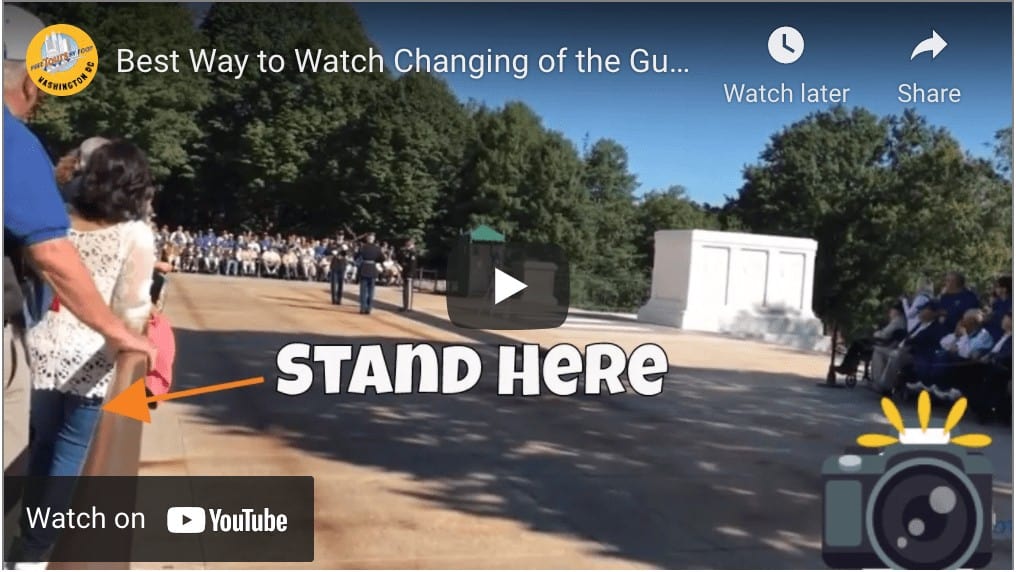
You'll want to exit the Tomb area by keeping the amphitheater to your right and then behind you as you head down the hill along the flagstone sidewalks. Before you reach the set of circular benches, you'll see an additional flagstone sidewalk to the right and in that corner a tall brown headstone that says Louis on the back.
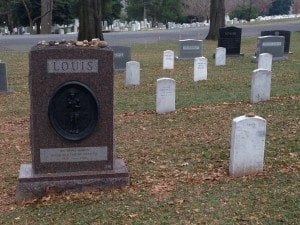
(Stop Z) - Joe Louis - Joe Louis Barrow is not known for his military career but rather his boxing. As the heavyweight champion from 1937 to 1949, he defended his title more than twenty-five times against the best from all over the world.
This included the 1939 bout in Yankee Stadium against the German fighter, Max Schmeling who was hailed by Adolf Hitler as an ideal. The "Brown Bomber" Louis knocked out Schmeling in two minutes and four seconds. Louis joined the Army as a private in 1942 and traveled for the next three years performing for over two million soldiers in more than 96 matches.
Louis was more than just a heavyweight boxer. He was an inspiration to society in a time of depression and war. Though technically not eligible for burial in Arlington National Cemetery, upon his death in 1981 President Ronald Reagan waived requirements so Joe Louis could be buried here.
His former challenger, and friend, Max Schmeling was a pallbearer and helped pay for his funeral expenses. His wife Martha would be buried there ten years later. The back of his tombstone visible from the sidewalk depicts his heavyweight championship career.
To the right of Joe Louis is a small white headstone marking the grave of Lee Marvin, famed actor best known for his role as Major John Reisman in the movie the Dirty Dozen. Marvin won the Academy Award for Best Actor in 1965 for his role in Cat Ballou.
To exit the cemetery, you'll continue through the circular set of benches to reach Roosevelt Drive. Turn left and follow this road out of the cemetery. You'll pass by Sir John Dill and Staff Sergeant William Windrich again before seeing the Visitor Center ahead.
Written by Rebecca Grawl, Canden Arciniega and Stephen Pickhardt
Choose a Destination... I want them all PLUS general travel tips. Amsterdam Berlin Boston Charleston Chicago Dubai Lisbon London Los Angeles Miami Nashville New York City New Orleans Paris Philadelphia Prague Rome San Francisco Washington DC
About The Author
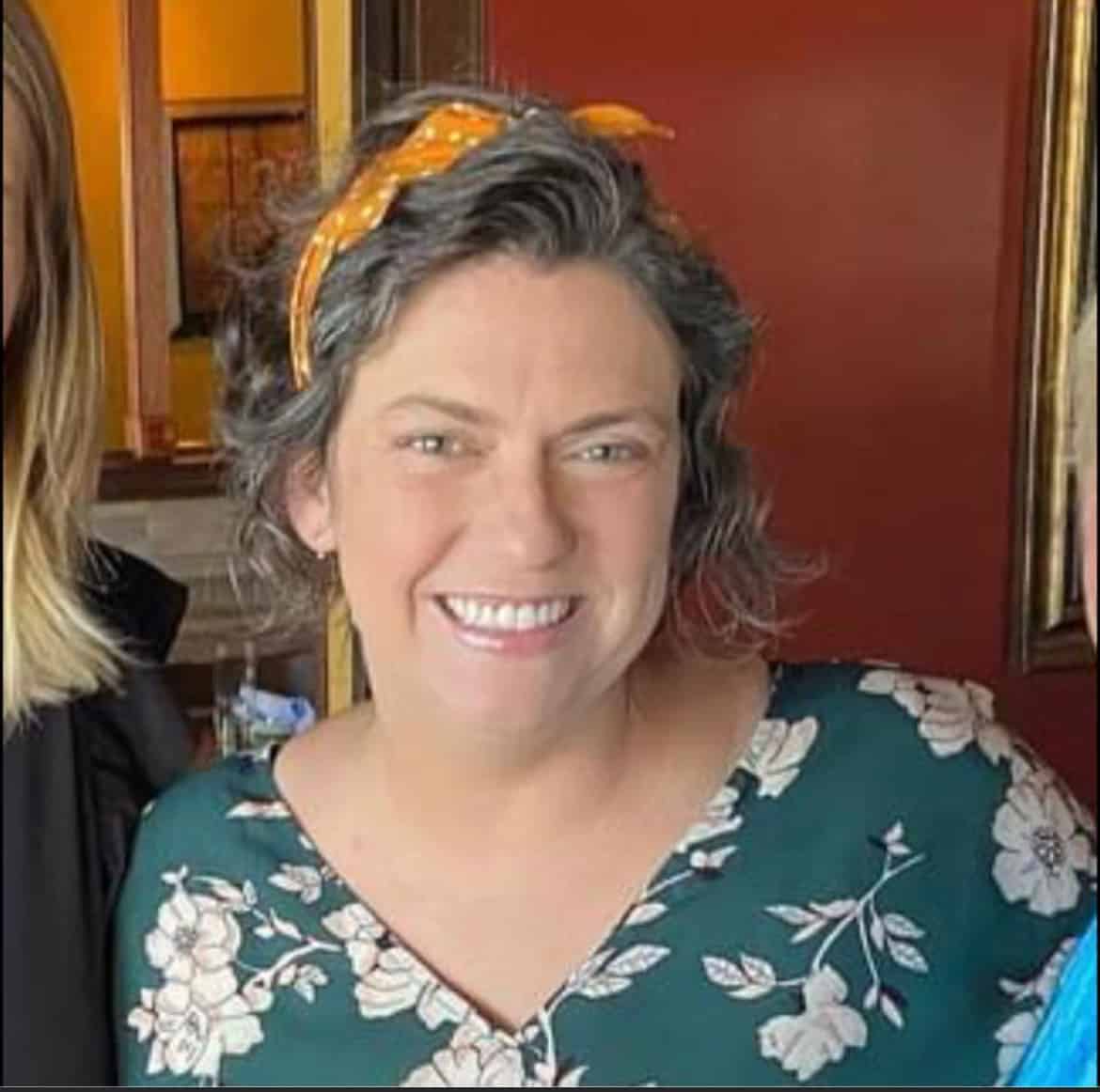
Canden Arciniega
North america, united kingdom & ireland, middle east & india, asia & oceania.
Account Options
- Skip to global NPS navigation
- Skip to this park navigation
- Skip to the main content
- Skip to this park information section
- Skip to the footer section

Exiting nps.gov
Alerts in effect, plan your visit.
Last updated: July 1, 2022
Park footer
Contact info, mailing address:.
Arlington House, The Robert E. Lee Memorial 700 George Washington Memorial Parkway c/o Turkey Run Park McLean, VA 22101
703 235-1530
Stay Connected

Search Results
We are sorry, no results were found for your search .
Arlington Tours
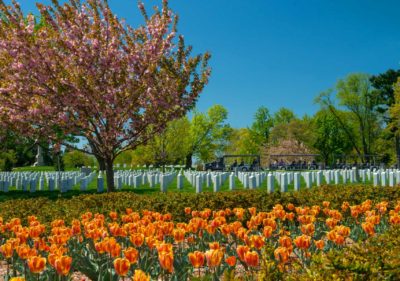
Honor Remember Explore
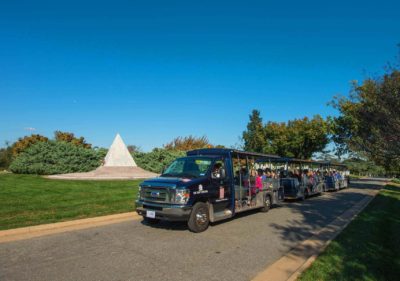
Arlington National Cemetery
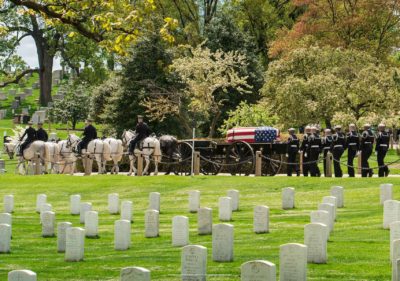
Awe-Inspiring Washington DC Tours
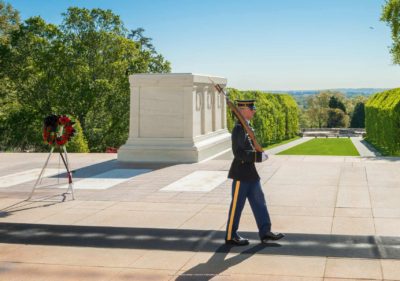
the Unknown Soldier
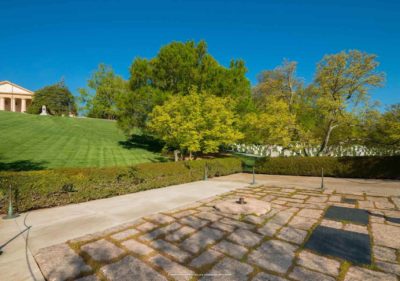
Kennedy Family Gravesite

ABOUT THE TOUR
Arlington National Cemetery is an enduring tribute to those who’ve dedicated their lives to defending the ideals of our nation. A visit here will leave an indelible impression on your spirit.
Tours depart from Welcome Center: 8:30am – 4:00pm. Open 363 days a year.
Closed on Wreaths Across America: Wreaths In Day (December 2024 date coming soon) and Wreaths Out Day (January 2025 date coming soon).
Special Operating hours:
Memorial Day and Veterans Day: Tours begin at 2:00pm.
Check tour updates for the latest info.
CEMETERY INFORMATION
Arlington National Cemetery is open 365 days a year.
8.00 am - 5.00 pm
TOUR BROCHURE
Changing of the guard.
October 1 - March 31
The guard is changed every hour on the hour.
April 1 - Sepember 30
The guard is changed every half hour.
VISITORS WITH DISABILITIES
Handicap accessible vehicles and assisted listening devices are available upon request. Those with a valid disability placard or a proof of disability documentation will be able to ride the interpretive bus service at no cost with one companion. Sign language interpretation of tours is also available upon request provided that one week notice is given. We recommend tour visitors in wheelchairs to be accompanied by someone to assist them.
We’ve got several options to choose from to help you maximize your time in DC
Arlington National Cemetery Tours - General Admission
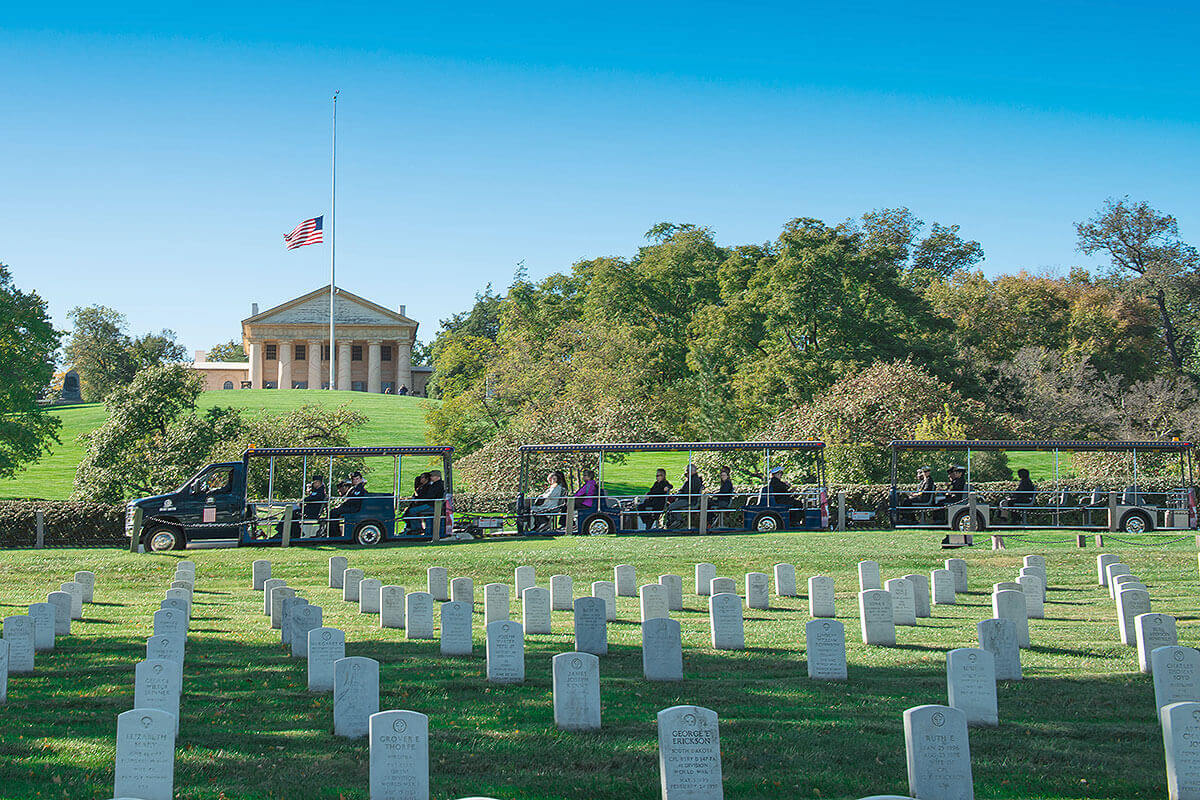
- Tours depart every 30 minutes
- 6 stops on weekdays and 9 stops on weekends
- Relax on our comfortable tour vehicles
- Learn about the cemetery's history and heroes from knowledgeable guides
- Be transported to notable graves and memorials
- Hop on and off at a variety of key points of interest
- 100% Satisfaction Guarantee
Washington DC Trolley Tour & Arlington Cemetery Tour Package
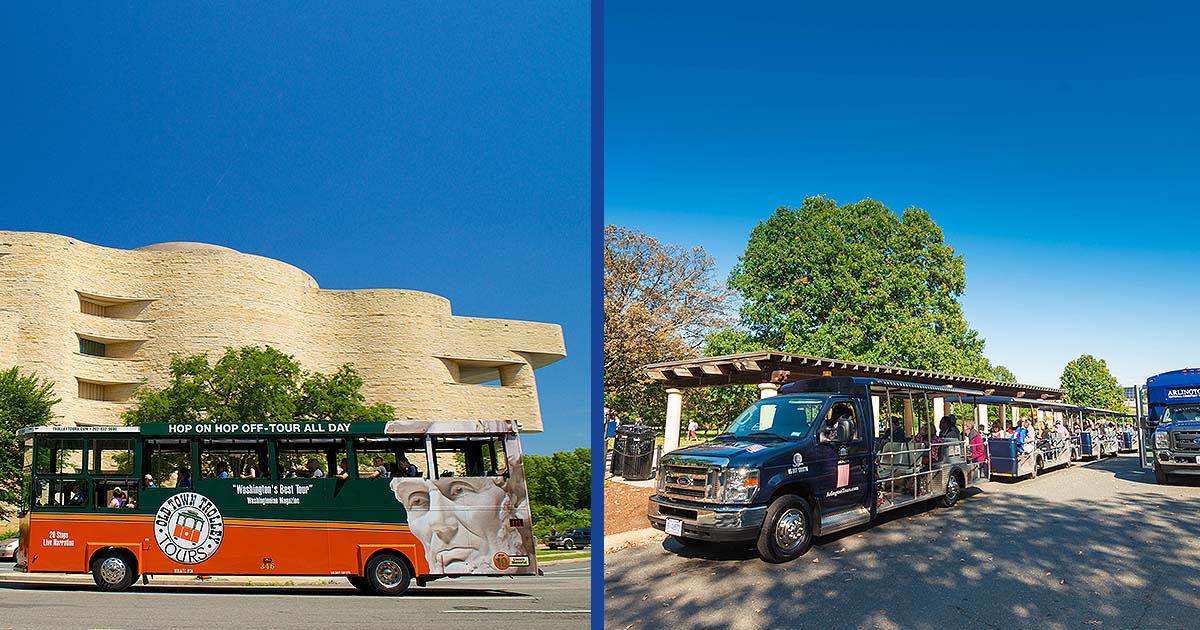
- Old Town Trolley Tours:
- Hop On & Off at 15 Old Town Trolley Stops
- Fully Narrated Tour of Washington DC
- Includes separate ticket to Arlington National Cemetery Tour:
- Make your way to Arlington Cemetery to begin your second tour
Monuments by Moonlight & Arlington National Cemetery Tour Package
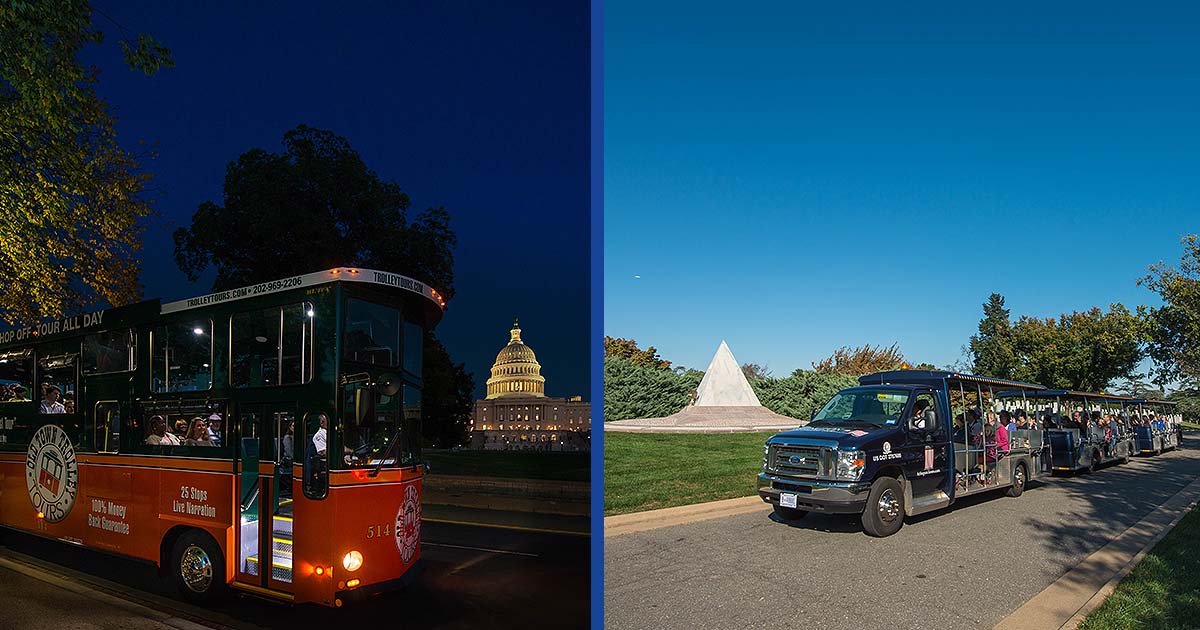
- Monuments by Moonlight Night Tour:
- See the city’s most popular monuments in a different light
- Stops at Iwo Jima Marine Corps Memorial, FDR, Lincoln, Vietnam Veterans, Korean War and Martin Luther King, Jr. Memorials
- Arlington National Cemetery Tour:
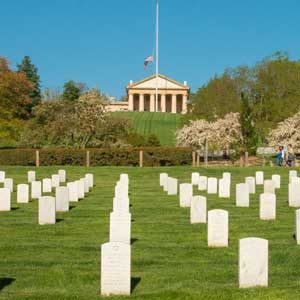
About Arlington
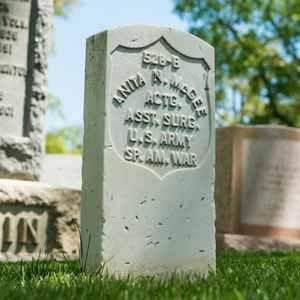

Famous Graves
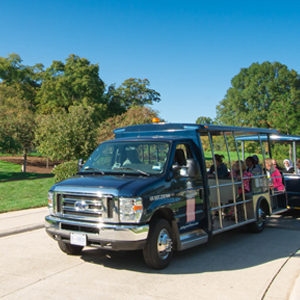
HISTORY & FACTS
A vacation to Washington D.C. would not be complete without visiting Arlington National Cemetery. Spread across 639 acres of rolling hills and beautiful gardens, this historic landmark is about 4 times the size of the National Mall and offers an exclusive tour service for guests looking to see the entire property in a manageable amount of time. Daily tours begin at the Welcome Center. A 45-minute loop gives visitors the chance to hop on and off at a variety of key points of interest. Don’t miss your opportunity to experience one of the most informative and awe-inspiring tours in Washington D.C.
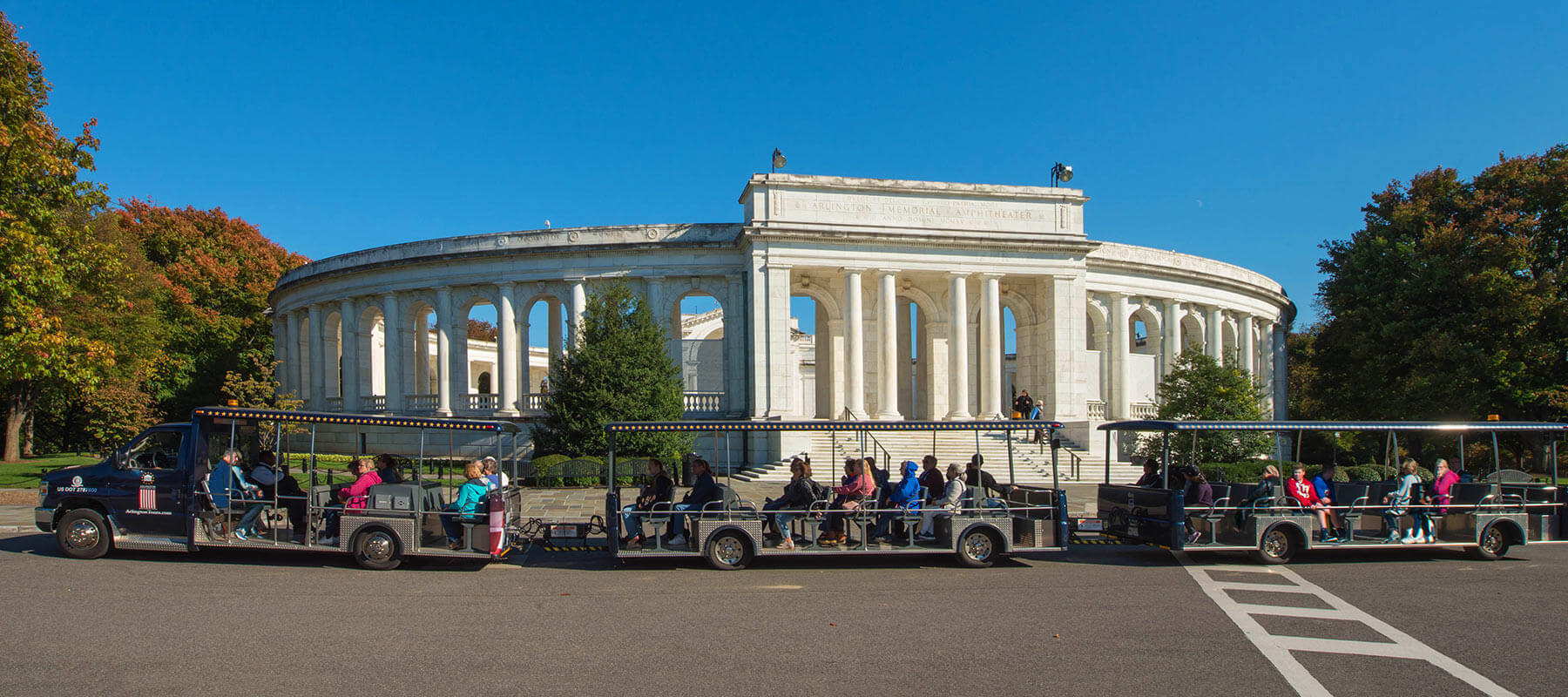
During the last 30 years, Historic Tours of America has educated hundreds of cast members and tour guides about the history of Washington D.C. It is truly an honor to be the official tour operator of Arlington National Cemetery and you won’t find a more dedicated staff of tour guides in the Nation’s Capital. Before, during, and after your tour, we’ll be available to answer questions and share some of the most interesting details of this national landmark.
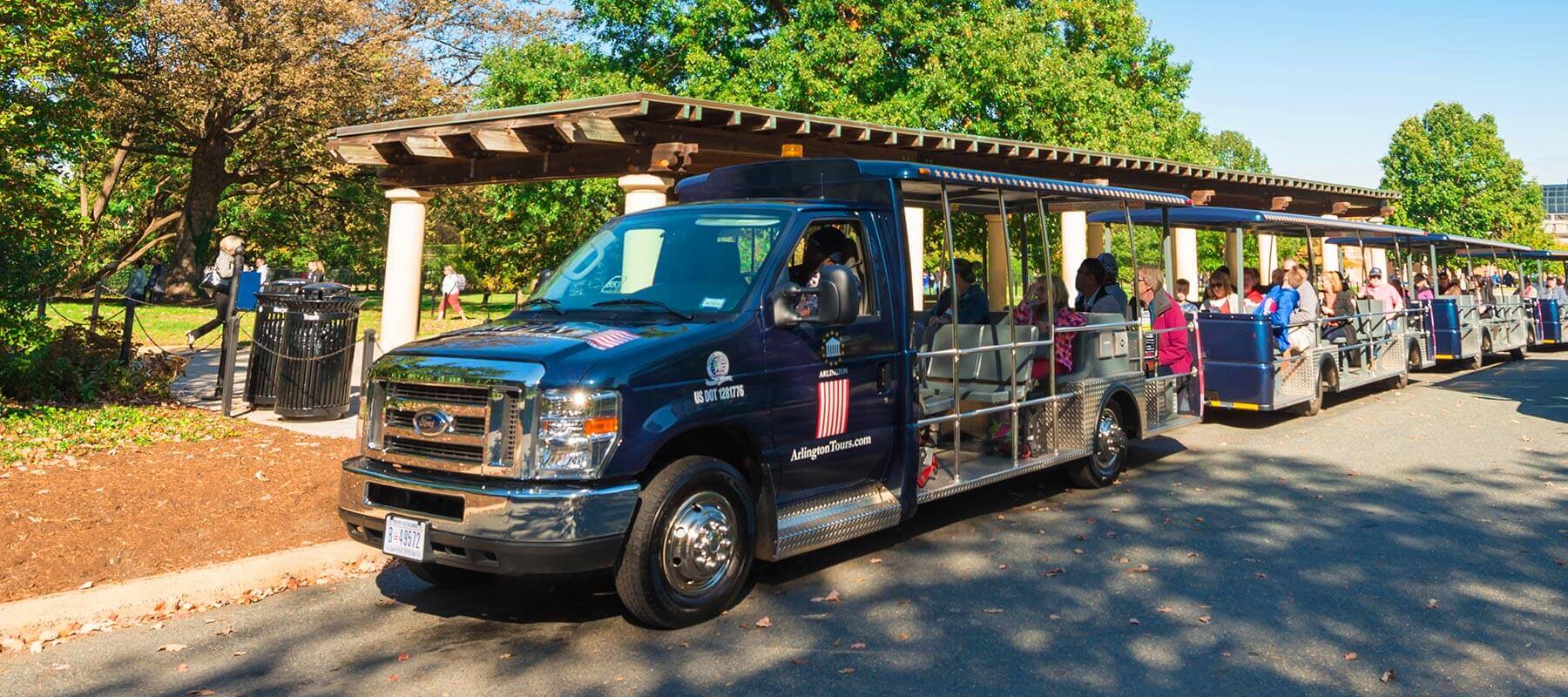
The Tomb of the Unknown Soldier is guarded 24/7/365 by volunteer Sentinels from the 3rd U.S. Infantry Regiment headquartered at Fort Myer, VA. Everyday at the top of the hour, a special ceremony is conducted to honor all American service members who are “Known But to God.” During the summer months, the ceremony is conducted on the half hour. This is one of seven stops on the guided tour and is definitely a must see for anyone visiting Washington D.C.
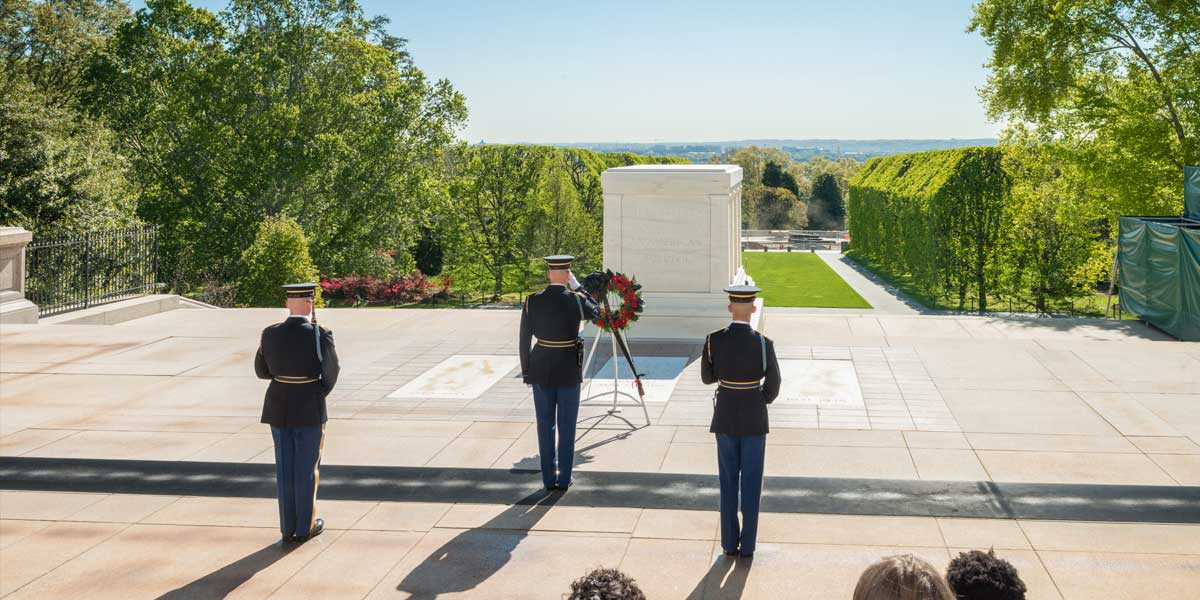
Touring historic landmarks is at the top of everyone’s list of things to do in Washington D.C. while on vacation. The National Mall has an amazing array of monuments to visit; but it’s definitely not the only place to experience the history of our country. Home to 30 different memorials and monuments, Arlington National Cemetery is an enduring tribute to the men and women who have served in the armed forces.
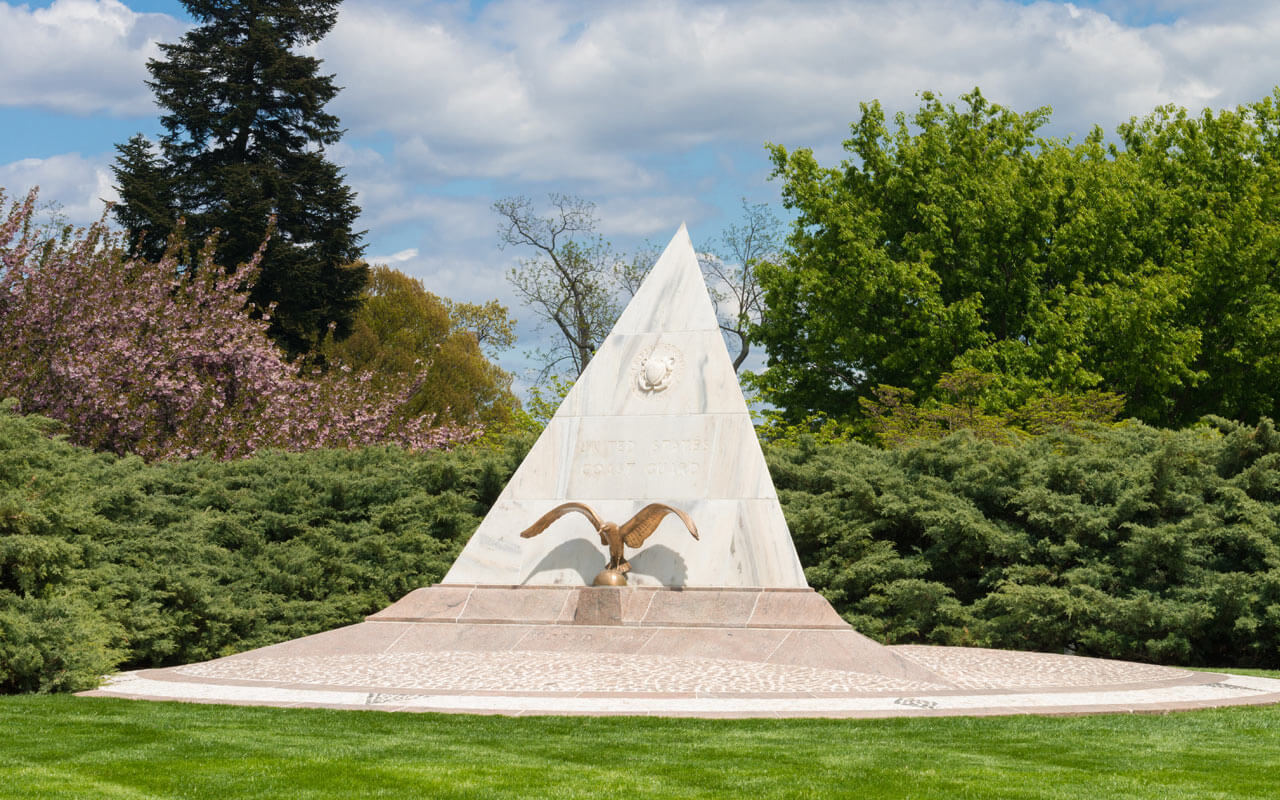
Frequently Asked Questions
Where is the arlington national cemetery located.
Arlington National Cemetery is located at the end of Memorial Avenue, across the Potomac River from Washington, D.C. It can be easily accessed from several major roadways in the D.C. area: Interstate 95, the Capital Beltway (I-495), the George Washington Memorial Parkway and the Baltimore-Washington Parkway (I-295).
Where can I purchase tour tickets?
Tickets are available in a variety of ways. Buy online at arlingtontours.com, visit an Old Town Trolley DC ticketing location or visit the Arlington National Cemetery Welcome Center at the front gate.
Does the tour run on holidays and holiday weekends?
Yes! The Arlington National Cemetery tour is open on all holidays and holiday weekends, including Memorial Day, Independence Day, and Veterans Day. The cemetery is open from 8:00am to 5:00pm, 364 days a year. The cemetery closes 1 day per year around December 16th for Wreaths Across America.
What is the daily operating schedule for Arlington National Cemetery tours?
The guided tram tours depart every 30 minutes. The tours run throughout the day, with the first tour departing at 9:00am and the last tour departing at 4:00pm.
Where does the tour stop?
During the week, the tour stops at the Tomb of the Unknown Soldier, the President John F. Kennedy Gravesite, Arlington House, and the Pershing Gravesite. On the weekends, the tour adds three additional stops: Sections 55 & 59, the Columbarium and Niche Wall, and the Pentagon Group Burial Marker/911 Memorial. You’ll have the opportunity to disembark and explore at your own pace. Hop on the next trolley and continue to be transported to notable graves and memorials.
What famous graves does the tour visit?
On the tour, you will visit the graves of President John F. Kennedy, his wife Jacqueline Kennedy Onassis, and his brothers Robert and Edward Kennedy. You will also visit the Tomb of the Unknown Soldier, which honors those who have died in service to their country. Additionally, you will be able to pay your respects to the graves of General John J. Pershing, General George C. Marshall, and General Omar Bradley. Finally, you will be able to visit the graves of the astronauts who died in the Challenger and Columbia space shuttle disasters.
Who is the most famous person buried in Arlington National Cemetery?
The most famous person buried in Arlington National Cemetery is undoubtedly John F. Kennedy, the 35th President of the United States. JFK was assassinated in Dallas, Texas in 1963 and was laid to rest in the cemetery in a state funeral. His grave is marked by an eternal flame, which has become a symbol of his legacy and a reminder of his life and service to the nation.
The cemetery is also the final resting place of many other notable figures, including General John J. Pershing, the first American to be promoted to the rank of General of the Armies, and General Omar Bradley, the last surviving five-star general of World War II. Other famous people buried in the cemetery include Supreme Court Justice Thurgood Marshall, astronaut and Senator John Glenn, and civil rights leader Medgar Evers.
Who was the first person interred at Arlington National Cemetery?
The oldest grave at Arlington National Cemetery is that of William Henry Christman, a private in the Union Army during the Civil War. Born in 1843, Christman was only 19 years old when he enlisted in the 67th Pennsylvania Infantry in April of 1861. He served with distinction until his death on May 11, 1864, from wounds he received in the Battle of the Wilderness. Christman was buried in the cemetery on May 15, 1864, making him the first soldier to be interred at Arlington .His grave is located in Section 27, near the Tomb of the Unknown Soldier.
Where does the Changing of the Guard occur and at what time?
The Changing of the Guard at Arlington National Cemetery takes place every hour on the hour from October 1st to March 31st, and every half hour from April 1st to September 30th. The ceremony begins with the guard marching from the Tomb of the Unknown Soldier to the Tomb of the Unknowns, where they will stand watch for the next hour.
How long is actual ceremony for Changing of the Guard?
The ceremony itself is a brief but powerful display of respect and reverence, lasting about 30 minutes. The ceremony begins with the Old Guard marching from the Tomb of the Unknown Soldier to the Memorial Amphitheater. The Old Guard is accompanied by a band playing a slow, somber tune. Once the Old Guard arrives at the amphitheater, they are joined by the New Guard, who march in from the opposite direction. The two guards then stand at attention and salute the Tomb of the Unknown Soldier.
Are burials and funerals still taking place at Arlington National Cemetery?
Yes, each weekday there are between 27 to 30 services, and Saturdays have four to five services. Arlington National Cemetery serves as a distinguished cemetery, deeply committed to honoring our nation’s heroes. In consideration of those being laid to rest and their loved ones, Arlington National Cemetery Tours Inc. tries to avoid scheduling tours during funerals. Please understand that funerals, events, ceremonies, and groups may occasionally cause delays or disruptions during your narrated tram tour.
- America Unscripted
- Lincoln Assassination Unscripted
- Arlington National Cemetery
- Capitol Hill
- Off Menu Union
- Get the Book

Arlington National Cemetery Walking Tours
Our guide, your group. a once in a lifetime experience..
Join an expert guide on a guided walking tour of Arlington National Cemetery. Learn the history of Arlington National Cemetery, from its days as a plantation, then military outpost during the Civil War, and how it became the cemetery it is today.
Visit the graves of key figures in history and learn their stories, including decorated veterans, Presidents, and US Supreme Court Justices.
Witness the Changing of the Guard at the Tomb of the Unknowns and learn the history of the Tomb of the Unknowns and what it takes to become a guard for the tomb.
See more on your visit than most, as you explore areas of the cemetery often missed including some of the original Civil War graves, the Nurses section, and more!
- What You'll See
- Things to Know
- President John F Kennedy Memorial Gravesite
- The Tomb of the Unknowns
- The Changing of the Guard
- Civil War Graves
- The US Supreme Court Justices
- Audie Murphy
- President William Howard Taft
- Robert Todd Lincoln
- USS Maine Memorial
- Space Shuttles Columbia and Challenger Memorials
- Much More!!!
- There will be a moderate amount of walking involved. Dress accordingly
- Umbrellas recommended (great for rain or to escape the sun)
- Reservations required
- Meet your guide at the Arlington National Cemetery Visitors Center
- Valid government ID required for entry
Group Tours Adult – $49 Child – $39


- Washington DC
- Tour Guides
DC Highlights and Arlington Cemetery Bus Tour
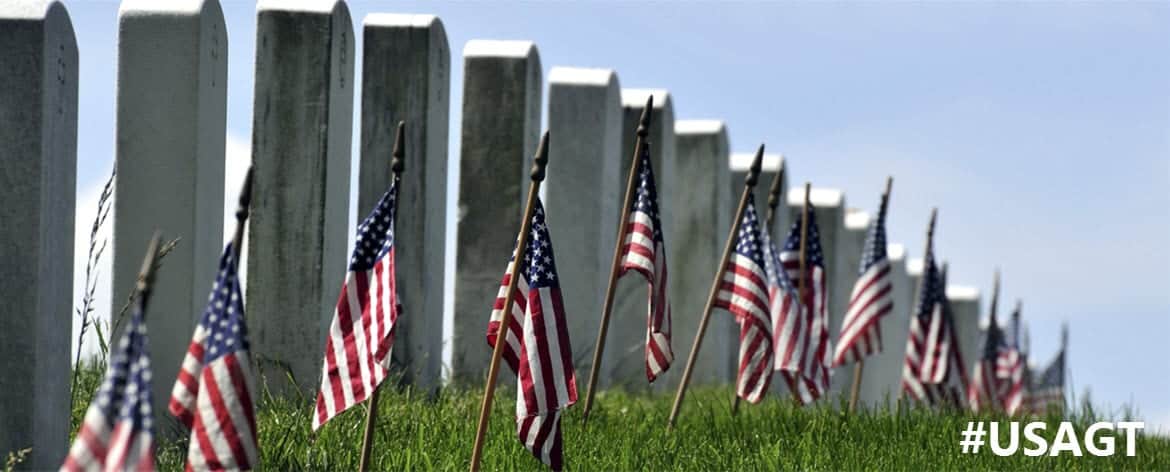
Experience Washington DC and Arlington, Virginia on this full-day tour! Visit DC’s most famous landmarks and monuments with 10 to 15 minutes at each stop, with your personal guide, on the grounds of the U.S. Capitol Building and the White House, as well as stops at the Vietnam Memorial, Lincoln Memorial, Korean War Memorial, World War II Memorial, and Martin Luther King Memorial.
In addition, experience a narrated trolley tour of the Arlington National Cemetery (self-guided tour with tickets for a narrated trolley tour). Take the tour of the Arlington National Cemetery including weekday stops near the Ord & Weitzel walking gate to see President John F. Kennedy gravesite, U.S. Coast Guard Memorial, U.S. Army Gen. John J. Pershing’s gravesite, the Tomb of the Unknown Soldier, and the Arlington House (The Robert E. Lee Memorial). Weekend service includes stops near Sections 55 and 60, as well as the September 11 Memorial. Tour ends at Arlington National Cemetery.
Google Reviews
Why type of buses does usa guided tours use.
Our luxury tour buses provide a comfortable and climate-controlled environment for an enjoyable touring experience, while also offering protection from the elements. We cater to various group sizes with a diverse fleet of vehicles, from SUVs to premium motor-coaches, ensuring that our private tours can be customized for couples or large groups alike. To maintain a more intimate atmosphere on our public tours, we intentionally limit the capacity of our tour buses to keep the average group size small. We do our best to keep large, same-party groups together on the same bus, but please remember that the seating is assigned on a first-come, first-served basis. Once you claim your seats – they’re reserved only for you for the duration of the tour.
Are we allowed to bring luggage on the tour?
Unfortunately, our shuttles are not wheelchair accessible, nor is there storage for baby strollers. If you have a wheelchair, please call us to make special vehicle arrangements for your tour. Some of our tours involve longer walks so if you like, you may stay on board the shuttle, near the landmark, without exiting the shuttle bus every time.
What is USA Guided Tours cancelation policy?
Free Cancellation up to 24 Hours in Advance > if you cancel your booking 24 hours in advance of your tour departure time – a full refund will be issued
Free Cancellation up to 1 Hour in Advance With Tour Booking Insurance > if you purchase Tour Booking Insurance at $5.99 per person, booking cancellations may be made up to 1 hour in advance of your tour departure time for a full refund
What are the blackout dates for tours?
Jan 1 New Year’s Day – All Tours Closed Jan 20 March for Life – Day Tours Closed Mar 18 Rock ‘n’ Roll Marathon – Day Tours Closed Apr 2 Cherry Blossom Ten Miler – Day Tours Closed
Apr 15 National Cherry Blossom Parade® – Day Tours Closed May 7 National Women’s Half Marathon – Day Tours Closed
May 28 AMVETS’ “Rolling to Remember” – Day Tours Closed May 29 Memorial Day – All Tours Closed July 4 Independence Day – All Tours Closed Aug 28 The Commitment March – Day Tours Closed Oct 8 Army Ten Miler – Day Tours Closed Oct 29 Marine Corps Marathon – Day Tours Closed Oct 31 Halloween – Night Tours Closed Nov 23 Thanksgiving Day – All Tours Closed Dec 24 Christmas Eve – Night Tours Closed Dec 25 Christmas Day – All Tours Closed Dec 31 New Year’s Eve – All Tours Closed

DC Highlights and Washington Monument Tour
Washington, DC is known for national monuments built on an epic scale, and few match the splendor of the George Washington Monument!
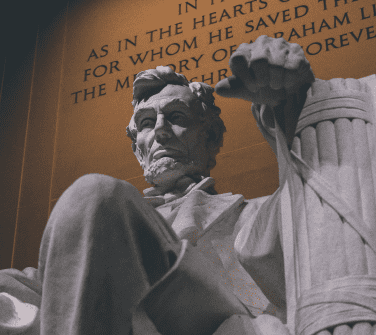
Best of DC — VIP Bus Tour
Experience Washington DC like a VIP: Our ultimate day tour with exclusive access to the National Archives and the U.S. Capitol Buildings. Book now for a presidential journey!
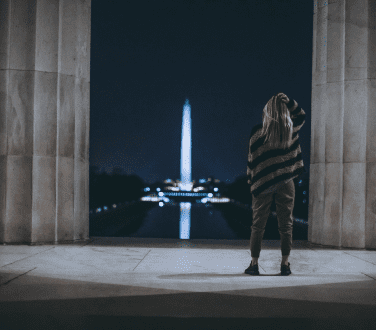
DC at Dusk Bus Tour
Experience the enchantment of Washington DC at night: Award-winning tour with expert guides and luxury transport. Book your memorable evening journey today!
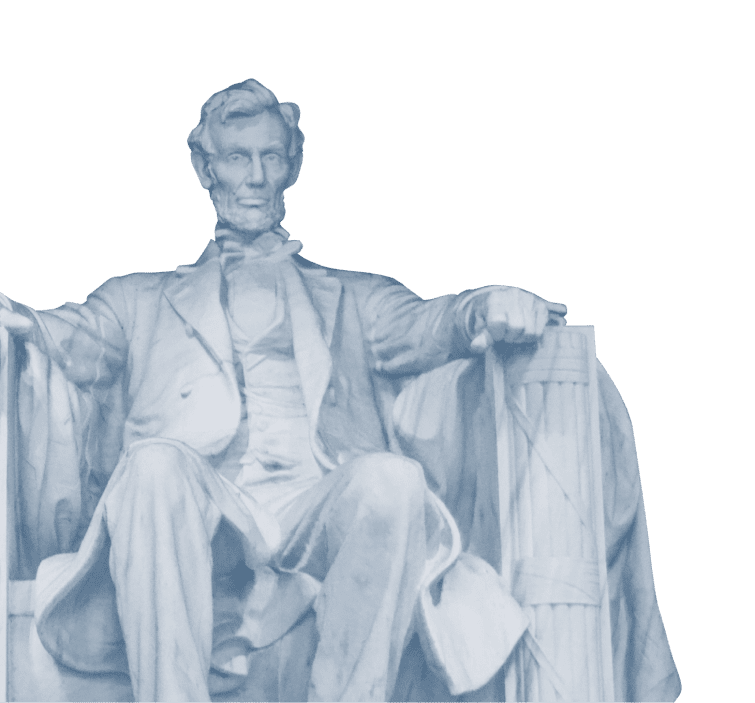
Not Exactly What You’re Looking For?
Book a private tour and explore DC on your terms!
This website uses cookies to ensure you get the best experience on our website. By using our site you consent cookies.
Privacy Overview

IMAGES
COMMENTS
Welcome to Arlington National Cemetery. Duration: This tour should take you approximately 3 hours. Distance: It's approximately 2 miles total walking. (Warning: there is uphill walking for the first half of this tour) (Stop A) - The first stop for any visit to America's most hallowed grounds is the Visitor's Center.
Education > Tours. Tours at Arlington National Cemetery. Our self-guided walking tours offer thematic explorations of Arlington National Cemetery. Whether you are visiting in person or virtually, use these tours to learn about some of the approximately 400,000 people buried here, as well as the cemetery's monuments, landscape and history.
Arlington National Cemetery welcomes visitors to explore the rich history found within its hallowed grounds. The cemetery is expansive - 639 acres. Walking distances and hills require moderate physical exertion. An alternative to walking is the interpretive tour bus, which stops at John F. Kennedy's gravesite, the Tomb of the Unknown Soldier ...
Media Credentials. #Tomb100 Walking Tours. Visit the Tomb of the Unknown Soldier and the gravesites of individuals related to the Tomb's history. On November 11, 1921, an unknown American soldier who died in World War I was laid to rest at the Tomb of the Unknown Soldier. On these self-guided walking tour, you will visit the Tomb of the Unknown ...
Tram Tours. Arlington National Cemetery Tours, Inc., a subsidiary of Historic Tours of America, Inc., is Arlington National Cemetery's only authorized interpretative tour bus service. • Tram tours depart every 20 minutes, from 8:30 a.m. to 4 p.m. daily. • The tour is a live-narrated, hop on/hop off tour making five stops: President John F. Kennedy gravesite, John J. Pershing gravesite ...
This is a self-guided tour with content of Arlington National Cemetery. This tour will take you between 2.5 and 3 hours. The first half of the tour is uphill, but the incline is slight, if long.
From within the Cemetery you can take the Arlington Cemetery Tour trolley, or walk, about 15-20 minutes from the Arlington National Cemetery Visitor Center Security Access Point up a hill to Arlington House. ... Restricted Areas The self-guided tour is restricted to the first floor south wing only. Stay on the carpets and do not cross the rails ...
Open Daily 8:30am-4:00pm. Last tour departs at 4:00pm; * Ord & Weitzel pedestrian gate will be closed from July 24th through August 31st for both vehicular and pedestrian traffic. Visitors will not be able to access the Iwo Jima statue from inside the cemetery. Arlington Tours will not make the stop at the gate until it is re-opened.
Welcome to Arlington National Cemetery, our Nation's most hallowed ground. This historic cemetery bears witness to our American heritage and the military service and sacrifice of men and women in uniform throughout our history. ... Check out our self-guided walking tours! Themes include the service branches, World War II, African American ...
Welcome to Arlington National Cemetery, our Nation's most hallowed ground. ... Walking Tours: Medal of Honor. More than 400 Medal of Honor recipients are buried at ANC. Our three walking tours highlight a selection of their stories, for a visit to the cemetery or for virtual learning. Learn More.
Tour Duration: 2 Hour (s) Travel Distance: 4.9 Km or 3 Miles. Self-guided walking tour: Arlington National Cemetery Tour in Washington D.C., USA. The detailed walk route map can be downloaded to your mobile device for turn-by-turn travel directions.
Monday - Friday: 8:00a - 4:30p Saturday: 9:00a - 3:00p Cemetery open daily Dawn to Dusk
Meeting Point: Inside the Arlington National Cemetery Visitor Center, beside the wax statue of the bugler.Entrance lines can be long in peak season. To ensure a prompt tour, arrive early.. Duration: Approx. 3 hours, walking (tram tickets available for purchase upon request) Highlights: JFK Gravesite, Arlington House, Tomb of the Unknown Soldier, Changing of the Guard Ceremony, the Challenger ...
See the moving Changing of the Guards at the Tomb of the Unknowns on a guided walking tour of Arlington National Cemetery. Be perfectly placed for good views of the moving ceremony, then continue to some of the cemetery's most important gravesites and memorials, including places dedicated to John F. Kennedy, the USS Maine, Second World War soldier Audie Murphy, and more, learning the ...
2-Hour Arlington Cemetery Guided Walking Tour in Washington DC. View the ceremonial Changing of the Guards at the Tomb of the Unknowns. Visit some of the cemetery's most important memorials, including the USS Maine Mast Memorial. Visit the grave of John F. Kennedy, as well as Jackie Kennedy, Robert Kennedy and Edward Kennedy.
Arlington National Cemetery Tours - General Admission. From. $19.50. BOOK THIS TOUR. Tours depart every 30 minutes. 6 stops on weekdays and 9 stops on weekends. Relax on our comfortable tour vehicles. Learn about the cemetery's history and heroes from knowledgeable guides. Be transported to notable graves and memorials.
The Official Website of Arlington National Cemetery. Welcome to Arlington National Cemetery, our Nation's most hallowed ground. ... Tours will be held on October 13, 20, 27 and November 3. Learn More. Confederate Memorial Removal . ... Self-Guided Walking Tours ...
Join an expert guide on a guided walking tour of Arlington National Cemetery. Learn the history of Arlington National Cemetery, from its days as a plantation, then military outpost during the Civil War, and how it became the cemetery it is today. Visit the graves of key figures in history and learn their stories, including decorated veterans ...
Full description. Meet a licensed tour guide for a walking tour of the Arlington National Cemetery. Stroll through American history and pay tribute to the military and war heroes of the United States. During your tour, explore the largest military cemetery in the U.S. and the final resting place for more than 400,000 veterans from the fronts of ...
In addition, experience a narrated trolley tour of the Arlington National Cemetery (self-guided tour with tickets for a narrated trolley tour). Take the tour of the Arlington National Cemetery including weekday stops near the Ord & Weitzel walking gate to see President John F. Kennedy gravesite, U.S. Coast Guard Memorial, U.S. Army Gen. John J ...